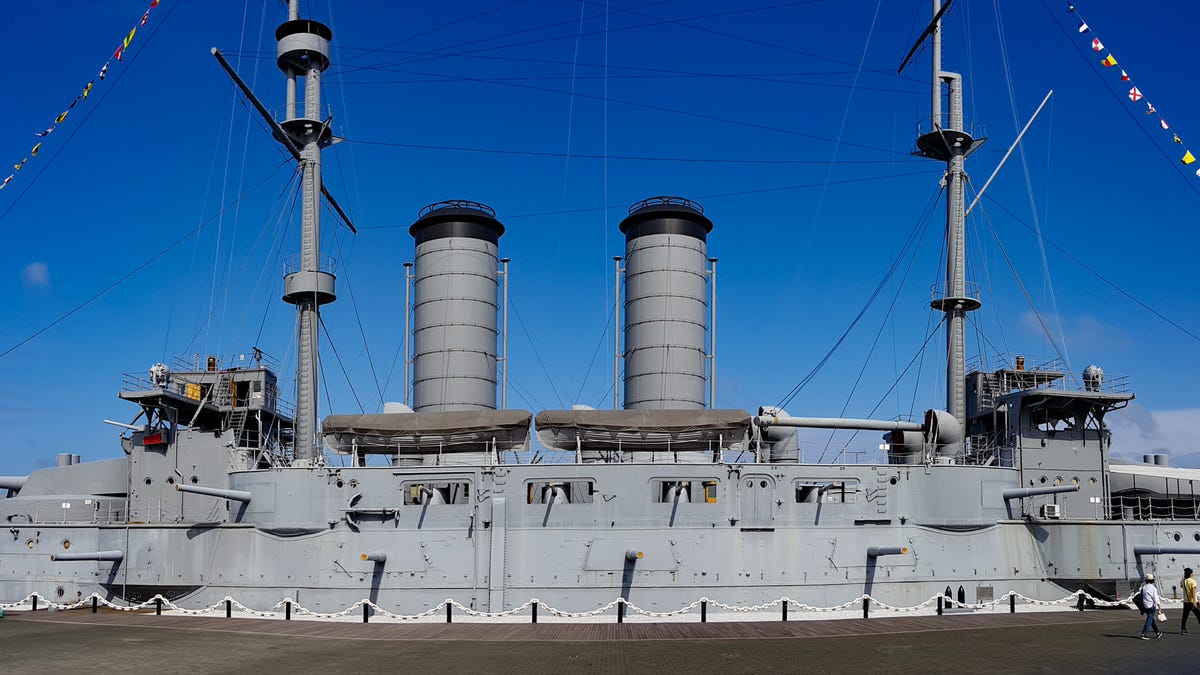 Why You Can Trust CNET
Why You Can Trust CNET Japan's 114-year-old battleship Mikasa: A relic of another time
The Japanese battleship Mikasa is the only surviving pre-dreadnought battleship in the world. It's 114 years old and a fascinating look into history. Here's a full tour.

An hour south of Tokyo, on the edge of the bay is a piece of history unique in the world. Embedded in concrete just a few feet from the water is the 114-year-old battleship Mikasa. It's the only surviving pre-dreadnought battleship, not to mention one of the only Imperial navy vessels still intact from that era.
After 21 years in service, the Mikasa was decommissioned, but not scrapped. Instead she was preserved at the request of the Japanese government, with her engines and armament removed, and her hull encased in concrete.
After several extensive restorations, the Mikasa today is a museum ship, and a fascinating look back into turn-of-the-last century naval design.
Here's a full tour.
Construction started on the Mikasa in 1899, half a world away from Japan, in Barrow-in-Furness, England. Commissioned in 1902, she had 4 12-inch main guns, 14 6-inch guns, 20 3-inch, and 4 torpedo tubes.
The Mikasa, named for a mountain in Japan, first served in the Russo-Japanese War where she took part in several battles.
Just days after the war, the ship's magazine exploded, sinking the ship. Salvaged and put back into use, it served coastal duties until after WWI. Though the Washington Naval Treaty limited the number of battleships, the historical nature of the Mikasa led to it being preserved minus its engines.
The following decades weren't kind to the Mikasa. Normal decay was exacerbated by odd private ventures, including selling off many of its parts, and converting the deck into a dance hall and an aquarium.
In the '60s however, restoration began, returning the ship largely to how it looked in its heyday.
Today, traveling about an hour by train from central Tokyo brings you to Yokosuka, the Mikasa's final home. It's a few minutes walk from the train station, but you can't miss it. Ships of all kinds float in Tokyo Bay, but the stacks, cables and guns of the Mikasa are certainly unique.
The tour itself is unguided, though there are often prerecorded stations scattered around which explain parts of the ship in English.
If you take your time, it takes about an hour to see the whole vessel. While the ship is not very big to begin with (432 feet/131.7m), there's almost nothing below deck. You see, the Mikasa isn't just encased in concrete, she's filled with it. The tour consists of the upper deck, the main deck, and the bridge, and though there's some storage down below, the rest is filled solid.
The restoration process may have begun 50 years ago but it is still ongoing. Many areas of the ship are furnished and look period-perfect. Others wait to be filled with artifacts of that era (and that hunt is ongoing). During my tour I happened to meet Captain Greg Kouta (JMSDF, Ret.) who is in charge of the Mikasa's restoration, as well as the ongoing preservation of the JMSDF Akishio which I had toured just a few days earlier.
Though the tour itself was short, it was a fascinating look at that middle-era of battleship design, after the steam-and-sails era, but before the massive dreadnought-era machines of the 20th century.
The Mikasa is open every day, except for the last four days of the year. Cost is 600 yen ($6 US) per adult, less if you're old or young.
If Tokyo isn't on your travel list, check out the photo tour above.
As well as covering audio and display tech, Geoff does photo tours of cool museums and locations around the world, including nuclear submarines, aircraft carriers, medieval castles, epic 10,000-mile road trips and more.
Also check out Budget Travel for Dummies, his travel book, and his bestselling sci-fi novel about city-size submarines. You can follow him on Instagram and YouTube.

